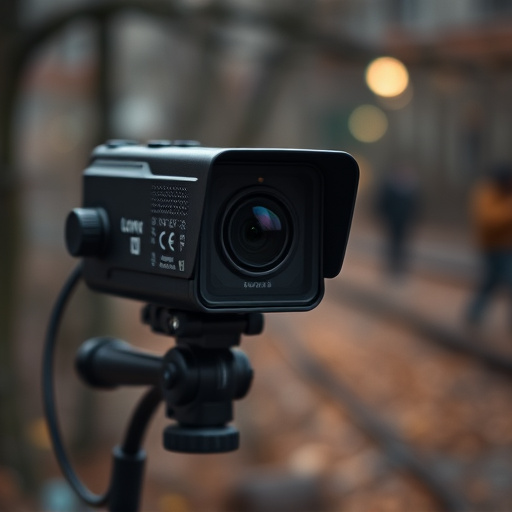Battery-operated nanny cam systems offer wireless surveillance with remote access via smartphone or computer. Key factors in selection include resolution, night vision, motion detection, and battery life. Versatile placement indoors and outdoors ensures unobtrusive footage capture. Environmental considerations like lighting and weatherproofing are vital. These systems provide convenience and flexibility for parents monitoring kids away from home, overcoming limitations with careful planning and high-quality models. Advanced tips include using a Battery Operated Nanny Cam System with motion detection, firmware updates, and encryption for enhanced security and discretion.
Uncover the secrets of wireless surveillance equipment with our comprehensive guide. From understanding the fundamentals to advanced detection techniques, we equip you with knowledge. Learn about the unique benefits and drawbacks of a Battery Operated Nanny Cam System—a popular choice for modern surveillance needs. Discover essential tips when selecting locations, tailored to your environmental and personal requirements.
- Understanding Wireless Surveillance Equipment Basics
- Choosing Location: Consider Environment and Needs
- Battery Operated Nanny Cam System: Pros and Cons
- Advanced Tips for Effective Wireless Surveillance Detection
Understanding Wireless Surveillance Equipment Basics
Surveillance equipment, especially battery-operated nanny cam systems, has evolved significantly in recent years, offering a range of options for homeowners and businesses alike. Understanding the fundamentals of wireless surveillance is key to selecting the right system. These systems typically consist of a camera unit, a receiver or base station, and a power source, often rechargeable batteries. The camera captures video and transmits it wirelessly to the base station, allowing you to monitor activity from a remote location via your smartphone or computer.
When choosing a wireless surveillance system, consider factors like resolution, night vision capabilities, motion detection, and battery life, especially for portable or hidden cameras like nanny cams. A reliable battery-operated system ensures discreet and continuous monitoring without the hassle of complex wiring. This flexibility makes it an ideal choice for temporary installations or areas where traditional power outlets are not readily available.
Choosing Location: Consider Environment and Needs
When selecting a location for your battery-operated nanny cam system, it’s crucial to balance environmental factors with your surveillance needs. The choice should consider both outdoor and indoor settings, depending on whether you’re monitoring a yard, playground, or living room. For instance, placing the camera near windows or doors can provide clear views of entrances, ideal for security. Alternatively, discrete locations like corners or behind furniture can capture spontaneous activities without attracting attention, perfect for childcare or pet monitoring.
The environment plays a significant role in equipment placement. Consider factors such as lighting—adequate illumination aids in video quality—and potential obstacles that might obstruct the camera’s view. Additionally, weatherproofing is essential if the camera will be exposed to outdoor elements. A battery-operated nanny cam system designed for versatility and adaptability will cater to these environmental considerations, ensuring optimal surveillance based on your unique requirements.
Battery Operated Nanny Cam System: Pros and Cons
Battery-operated nanny cam systems are a popular choice for parents seeking remote monitoring solutions, offering both convenience and discreteness. One of the primary advantages is their portability; these cams can be easily placed in various locations without the need for power outlets, making them ideal for busy parents who want to keep an eye on their kids while they’re away at school or day care. This feature also allows for flexible placement options inside homes, enabling users to capture hard-to-reach angles that traditional wired cameras might miss.
However, there are potential drawbacks. Battery life is a significant consideration; these systems require regular battery replacements or charging, which can be inconvenient and may disrupt the surveillance process. Additionally, while the wireless design provides ease of placement, it also introduces the risk of signal interference from other nearby devices, potentially leading to connection drops or reduced video quality. Nonetheless, with careful planning and selection of high-quality models, battery-operated nanny cams can provide efficient, hassle-free monitoring for modern families.
Advanced Tips for Effective Wireless Surveillance Detection
To enhance the effectiveness of your wireless surveillance setup, consider advanced tips like employing a Battery Operated Nanny Cam System. These systems offer unparalleled flexibility and discreetness due to their autonomous power source. By strategically placing these cameras in hard-to-reach or hidden areas, you can capture unaltered footage without drawing attention.
Additionally, integrating motion detection and real-time alerts can significantly improve your surveillance capabilities. Smart features like these allow you to respond swiftly to any activity, ensuring a robust security network. Regularly updating firmware and utilizing encryption protocols further safeguard your system, preserving the integrity of captured data.
In conclusion, selecting the right wireless surveillance equipment involves a blend of technical understanding and practical consideration. By grasping the fundamentals outlined in this article, from the basic components to advanced detection tips, you’re well-equipped to choose the ideal system for your needs. For those specifically interested in battery-operated nanny cam systems, weighing their pros and cons is crucial. Ultimately, the best solution combines effective monitoring with seamless integration into your environment.
